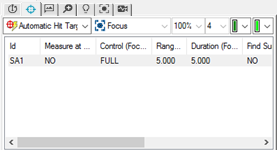 ). Otherwise, you can use AutoShutter to measure
using a manual machine. For information on the AutoShutter feature, see
"Setting up the Live View".
). Otherwise, you can use AutoShutter to measure
using a manual machine. For information on the AutoShutter feature, see
"Setting up the Live View".PC-DMIS uses the top plane (Datum A) for the primary alignment datum. A reference plane is commonly not required in 2D vision measurements. However, in this example, the datum plane is measured to accommodate dimensioning flatness. This is useful in situations where you might have feature control frames that reference a datum plane.
Since the approximate location of the part is known, PC-DMIS can operate in DCC mode.
If you are using a DCC machine, from the Probe
Mode toolbar, select DCC Mode ( ). Otherwise, you can use AutoShutter to measure
using a manual machine. For information on the AutoShutter feature, see
"Setting up the Live View".
). Otherwise, you can use AutoShutter to measure
using a manual machine. For information on the AutoShutter feature, see
"Setting up the Live View".
To measure a plane features for Datum A:
Select the Magnification
tab ![]() and adjust
the magnification until you increase it to the maximum setting
(zoomed in).
and adjust
the magnification until you increase it to the maximum setting
(zoomed in).
Select the Live View tab.
Position the camera over the part.
From the Illumination
tab ![]() , adjust
the Top Light to a value that makes the
surface visible but not too bright. Move Z to focus as necessary.
, adjust
the Top Light to a value that makes the
surface visible but not too bright. Move Z to focus as necessary.
Select the CAD tab.
From the Graphic Modes
toolbar (View | Toolbars | Graphic Modes),
select Scale-To-Fit ( ).
).
From the Graphics Modes
toolbar, select the Surface Mode button
( ).
).
From the Auto Feature
toolbar (View | Toolbars | Auto Features),
click Surface Point ( )
to open the Auto Feature dialog box for
Surface Point.
)
to open the Auto Feature dialog box for
Surface Point.
Click a point on the top surface.
Select the Hit Targets
tab ![]() , and
change the following parameters: Target Type = Automatic
Hit Target, Range = 5.0, Duration
= 5, and Find Surface Option = YES.
, and
change the following parameters: Target Type = Automatic
Hit Target, Range = 5.0, Duration
= 5, and Find Surface Option = YES.

For each Automatic Hit Target, double-click the option below each property, and type the specified value.
Click Create to add this edge point to the measurement routine.
Click another point on the top surface, then click Create.
Repeat the step above (click a point, then Create) until a total of 8 points have been created (PNT2 - PNT9).
Click Close to exit the Auto Feature dialog box.